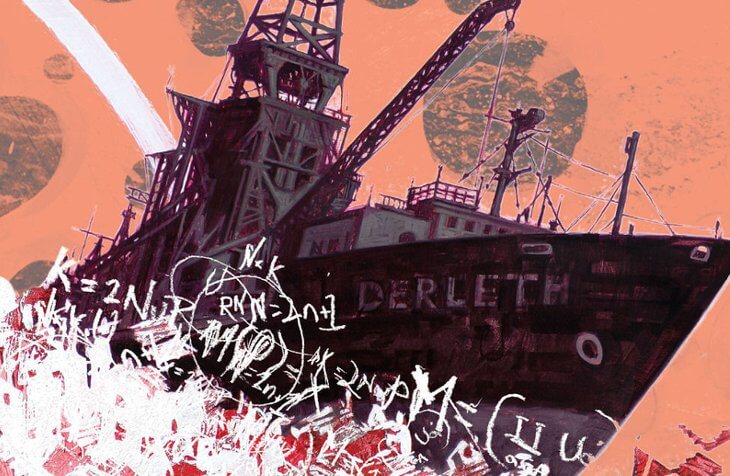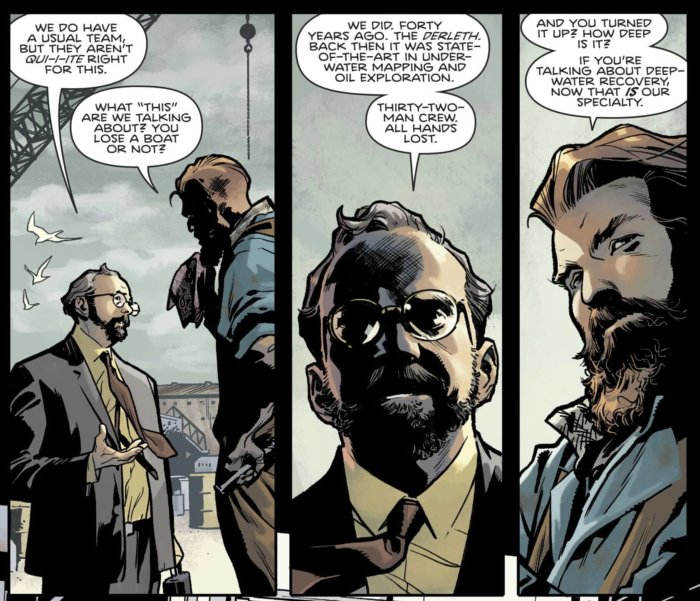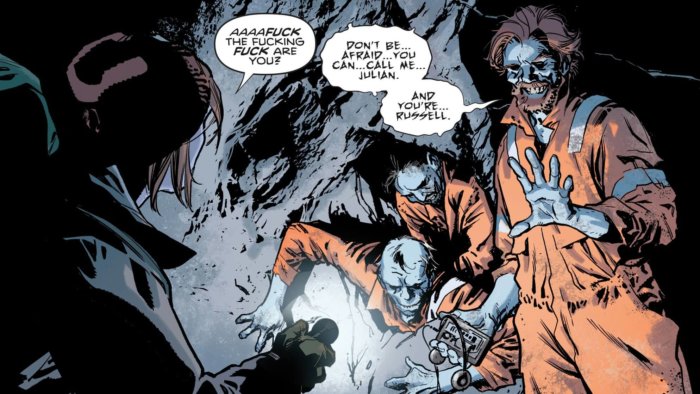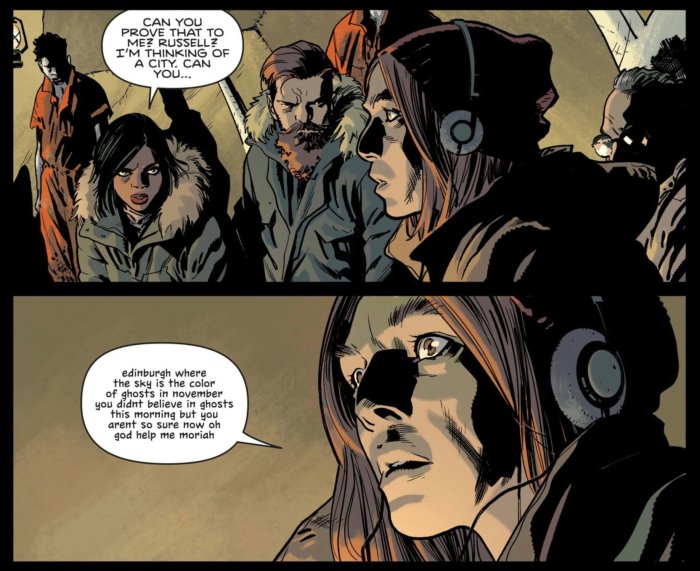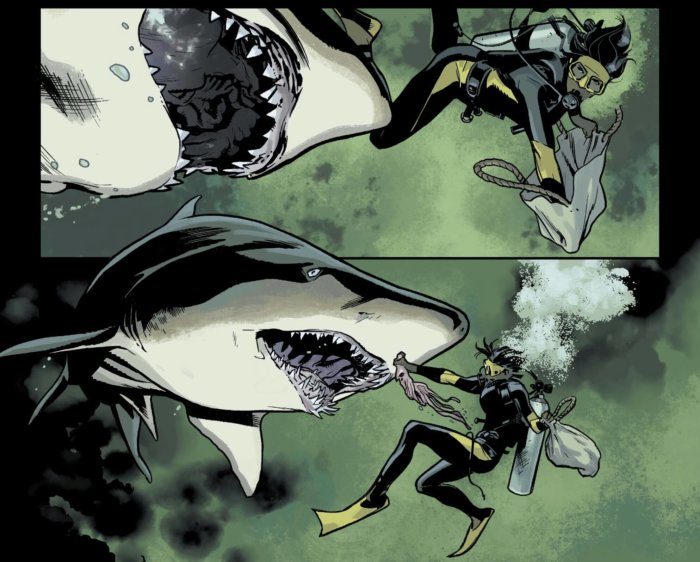The survey ship Derleth sank in April 1983, all hands lost. Forty years later, a coastal station picks up an automated distress call from the vessel: a recent tsunami has left the Derleth partly above sea level on an Alaskan reef, allowing its solar-powered systems to reactivate. The company that owns the ship hires salvage specialist Gage Carpenter and his crew to track down and investigate the Derleth.
Plunge
Deron Bennett (Letterer), Joe Hill (Writer), Stuart Immonen (Artist), Dave Stewart (Colourist)
DC Comics
November 17, 2020
Arriving at their destination, the team finds that the Derleth was not the only thing recovered from the deep. The ship’s crew, assumed dead, are now on dry land walking and talking – although whether they can be termed alive is another matter. It soon becomes clear that the ship and its crew encountered something mysterious, bizarre and perhaps even alien. Gage Carpenter’s team is shocked by the discovery, all except for one: a man involved with organising the expedition. He already had an idea of what would be found on that reef, and how it might benefit him personally…
Joe Hill makes no effort to hide his influences in scripting Plunge. With the names of The Thing director John Carpenter and Cthulhu Mythos co-writer August Derleth embedded into the comic, along with a scene in which the characters directly compare one another to the cast of Jaws, make it clear that we are seeing Lovecraftian horror filtered through Hollywood monster movies. The dreamlike Gothic strangeness seen in most of the Hill House titles has departed in favour of big, brash action-horror.
The principal characters never step far beyond the boundaries of genre convention. The roles of relatable everymen are taken by the salvage crew: tough guy Gage, nerdy Clark and hippie longhair Russell (the last two being referred to by Gage as Tweedledee and Tweedle-Dylan). Marine biologist Moriah is the representative of science and purveyor of exposition, while her partner Bill provides the love interest. Then we have David Lacome, the company representative. Cold and mercenary, he knows more than he lets on about the mystery of the Derleth and is perfectly willing to throw his cohorts under the boat if it would further his interests.
Plunge is the sort of story quite entitled to use such well-worn character types and narrative structure, as the familiar makes for the strongest contrast with the alien. The early chapters confront the protagonists with a flood of bizarre images: blind, reanimated corpses; mutated animals; eldritch carvings; giant aquatic worms; lengthy mathematical equations carved onto cave walls. As the team place their findings under the figurative microscope, the comic avoids the easy pitfall of over-explaining and demystifying its horrors.
Once established as characters, the zombie-like crew of the Derleth – who, it turns out, are animated by sapient alien worms – are cast as mediators between the mundane and alien worlds. In Lovecraft’s fiction, proximity to unknown areas of the cosmos generally leads to insanity; Plunge, on the other hand, posits that the human mind is quite capable of adapting to such insights – it is the body that will bear the burden.
The halting dialogue given to the Derleth zombies is a mixture of mathematics, philosophy and spirituality. When asked “how many of you are there”, a zombie representative replies that the answer “depends how you count…and how you define…’us’.” Later, the character mentions the Reimann hypothesis and Crouzeix’s conjecture as freely as he invokes God, Christ and Judas Iscariot. Decidedly eloquent, for a shipload of rotting zombies.
Of all the crewmembers, it is Russell – the hippie longhair hitherto used largely as comic relief – who gets closest to the higher plane of reality. The Derleth crew convert his Walkman into a psychic device and he promptly enters a trance, experiencing weird visions of the alien’s history and reading the minds of his cohorts. Those minds, incidentally, are occupied with a scuffle over a precious blue fluid in a vial dubbed the “ingot”, the mere proximity to which is enough to inspire a Gollum-like fixation in the characters – always a good sign when a story’s McGuffin carries psychological weight.
All of this is heady stuff for a comic that, on the surface, appears to be no more than a nostalgic riff on fondly-remembered eighties sci-fi/horror films. Artist Stuart Immonen had a substantial task in bringing Joe Hill’s world to life: even a problem as small as flat character artwork could easily have sunk the whole endeavour, as Plunge demands that we believe in the protagonists and their predicament. As it is, Immonen succeeds in creating a cast who feel as though they truly live and breathe between the panels, the smallest movements conjuring up nuanced interior lives.
Having illustrated a believable set of characters, the comic sends them into an equally believable landscape. We are taken through dank caves and undersea worlds, populated by gaunt zombies and weird alien creatures. Credit is also due to colourist Dave Stewart, who is responsible for much of the comic’s palpable atmosphere.
Come the finale, Joe Hill ties up the various character relationships while Immonen and Stewart depict the final manifestation of the alien lifeform with a filmic, big-screen flair. The influence of movies on comics has often been lamented, with too many titles falling back on widescreen panels as a narrative shortcut, but the climax to Plunge captures the feel of a cinematic spectacle: a fitting end to a comic that is intelligent, rather than merely imitative, in its borrowings from Hollywood.
While a self-evident love letter to eighties sci-fi/horror films and their pulp forebears, Plunge is also a confident demonstration of what solid sequential storytelling is capable of. It draws heavily upon predecessors in film and prose, yet never loses sight of the fact that it is first and foremost a comic – and a sterling one at that.

